SPECIAL ISSUE
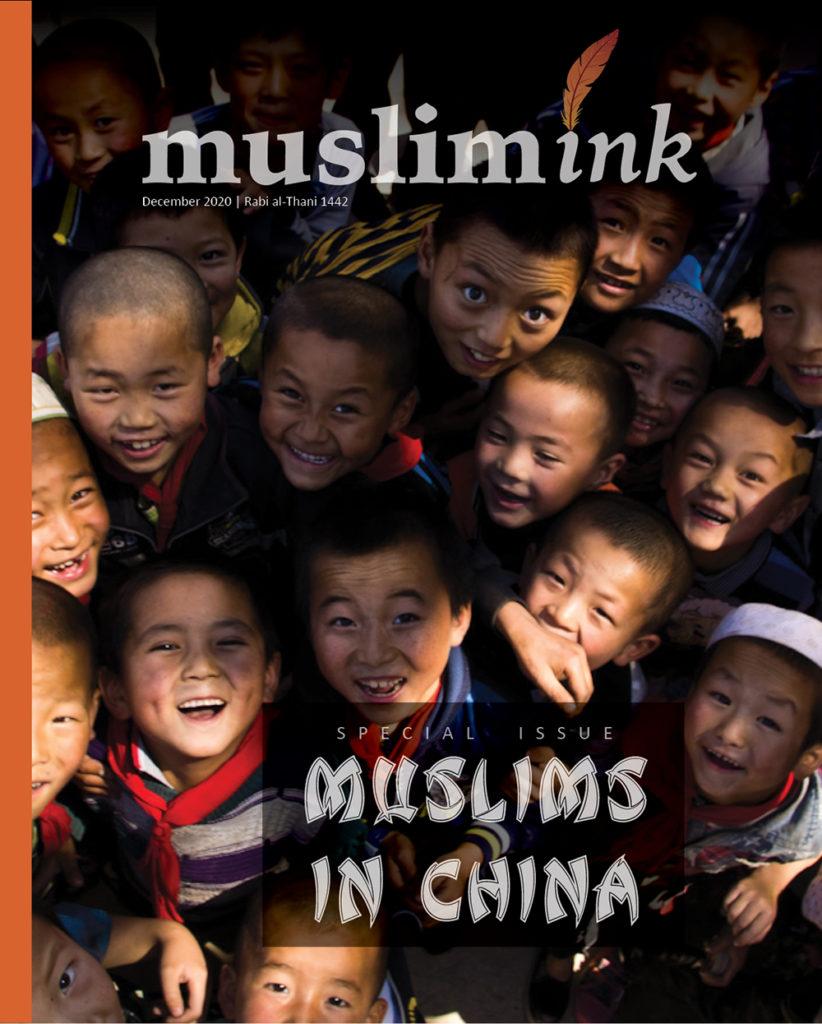


Why a special issue on Muslims in China
In Chinese language, Islam is called Yisilinjiao, which literally means “Pure Religion.” Muslims have lived in China for nearly 1400 years and played an important role during critical times of the country’s history. At their peak in the 18th century, Muslims numbered over 400 million in population.
Today, China is home to 60-80 million Muslims with about 11 million living in the Xinjiang province, where China has locked down over one million people. Muslims of Xinjiang province, popularly known as Uyghurs, are ethnically Turks and have lived under an “autonomous” rule within China. The semi-autonomous region has seen a few separatist movements and incidents of ethnic violence in the recent past.
The communist regime of China alleges that Xinjiang province is a potential bed of separatism threatening Chinese “unity” and “sovereignty.” The response from the Chinese government has seen an extreme form of forced assimilation that targets the Islamic faith and culture of Uyghurs. There are also reports that the crackdown on Islam is extending beyond the troubled Xinjiang province. The radical measures indicate that perhaps the CCP’s ultimate wish is to see everyone living in China become a single community by shedding their beliefs and embracing the communist ideology.
The Chinese government vehemently denies the reports and says it takes good care of its 56 ethnic and religious minorities. According to the government, the country is targeting what it has termed “the three evils” of “separatism, terrorism and religious extremism.” The most troubling is perhaps the ambiguity of what constitutes “extremism,” giving credence to the view that the CCP wants to shove communist values down people’s throats and will judge opposing beliefs as extremism. It is impractical that a nation of 1.4 billion people must all embrace the values espoused by the leaders of the communist party. Attempts to force the ideology will ultimately lead to what the CCP fears the most: civil unrest and the splintering of its sovereignty.
❝
The Communist Party came to power after promising religious freedom to Muslims
In the late 1970s, China had embraced a tolerant approach towards its minorities and allowed different religions and cultures to flourish. Muslims were able to freely practice and, during this period, Islam flourished in the country. China’s relations with Muslim countries improved and in 1980 the first group of Muslims from the People’s Republic of China went on Hajj with official approval. Daʽwah organizations worked on propagating Islam. Hundreds of Chinese Muslims went abroad to study Islam traditionally in Muslim countries like Saudi Arabia and Egypt.
However, the events that unfolded after 9/11 and the ethnic conflicts in Xinjiang province in 2008 and 2014 have steadily led to a deterioration of that tolerance and an extreme form of oppression against Uyghurs and their Islamic faith. International politics and misuse of the Uyghur issue for countries’ own interests against China have also exacerbated the issue.
It is important for China to understand that the religion does not promote separatist movements, which are ethnic in nature and have a history of their own. The spread of Islamic knowledge has not influenced separatism. Researchers have pointed out that the most Uyghurs simply want religious freedom, not an independent state.
Muslims as minorities have lived dutifully and peacefully under many governments. China is not oblivious to this fact. Muslims have been a critical pillar of support for various Chinese dynasties in the last 1370 years. In fact, the current ruling Communist Party came to power with the support of Muslims after promising them the freedom of religion.
Yet many Muslims around the world are unaware of this story. In our magazine’s special issue of Muslims in China, we go into the details of our history in China.
– Faraz Omar, Editor
- Why a special issue on Muslims in China
- HISTORY OF ISLAM IN CHINA
- Islam Arrives
- Emperor’s Dream About Muslims
- Muslims During the Tang Dynasty (618-907)
- The Battle of Talas and the Abbasid Victory
- Description of Muslims in Tang Manuscripts
- Muslims During the Song Dynasty (960-1279)
- Muslims in Yuan Dynasty (1271–1368)
- Ibn Battuta’s Adventurous Journey to China
- Muslims in Ming Dynasty (1368-1644)
- Muslims During the Qing Dynasty (1644-1912)
- Muslims in the Republic of China (1911-1949)
- Muslims in the People’s Republic of China(After 1949)
- In Pictures:Muslims in China
- Chinese Islamic Calligraphy
- The Muslim Quarter of Xian
- RECIPES: Uyghur Kebab and Naan
- The Diverse Muslim Ethnicities of China
- Challenges Muslims face in China
- How Chinese Muslim Women Are Protected
- Did Islamic Education Radicalize Chinese Muslims?
- Understanding the Uyghur conflict
- References
The Two Roads of Islam into China

7th-8th century: The first Muslim settlers in China were traders and they took the sea route to the southern part of the country. From the northwest, the Muslim caliphate continued its conquest and expansion into Central Asia, permanently ending China’s influence in the territories popularly known in the West as Transoxania and as ma waraa an-nahr in Arabic.
Where Muslims Live in China

Provinces with visible Islamic presence and where Muslims continue to live in large numbers.
HISTORY OF ISLAM IN CHINA
Islam Arrives
During the Caliphate of Uthman
❝
According to old Chinese Muslim manuscripts, the first masjid, the Great Mosque of Canton, was built by Saʽd ibn Abi Waqqas
Islam came to China within a few decades after the death of Prophet Muhammad ﷺ. According to legendary accounts of Chinese Muslims, the Sahabi, Saʽd ibn Abi Waqqas رضي الله عنه was sent to China during the caliphate of Uthman ibn Affan رضي الله عنه.
Secular historians dispute the story of whether Saʽd ibn Abi Waqqas actually came to China. Regardless, they agree, and there is considerable evidence that early Muslims did arrive in the 7th century, i.e., the first few decades of the Islamic era.
According to old Chinese Muslim manuscripts, the first masjid, the Great Mosque of Canton, was built by Saʽd ibn Abi Waqqas in Guangzhou in the 7th century. The masjid went through several renovations in history. The earliest surviving structure is a tower. The masjid is also popularly known as the Lighthouse Mosque.
Another masjid, the Great Western Mosque of Ch’ang-an (Xi’an) is said to have been built around 742. However, in the 1930s, Claude L. Pickens, an American Christian missionary to Muslims of China, found an inscription in the masjid that had a building permit of the year 705.
According to another legendary account, the Sahabi, Saʽd ibn Abi Waqqas and a group of companions first came to China from Abyssinia, after the first hijrah, during the lifetime of the Prophet ﷺ. Saʽd then came again during the caliphate of Uthman رضي الله عنه.
The Great Mosque of Canton in Guangzhou is said to have been first built by Sa’d ibn Abi Waqqas. Right: The only surviving structure from the original Guanghzhou mosque.
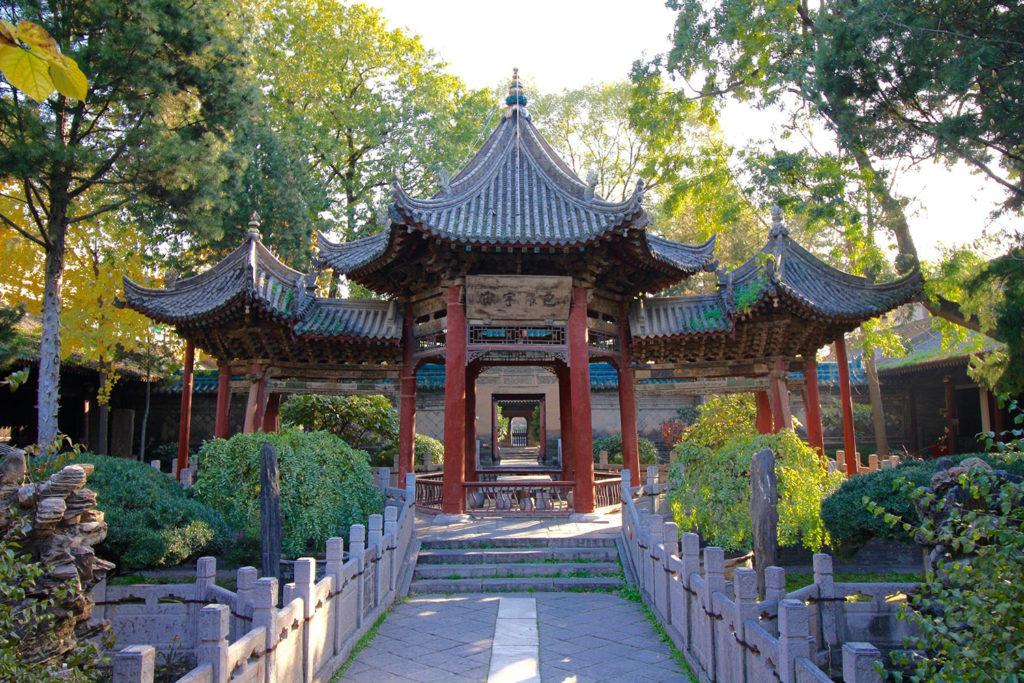
The Great Western Mosque of Xian, originally built in 742CE, but rebuilt during the Ming dynasty
Emperor’s Dream About Muslims
According to the legends, Chinese emperor T’ai Tsung (598-649 CE) of the Tang dynasty saw a dream of “a turbaned man and monsters.”
“The man in the turban, with his hands clasped and murmuring prayers, pursued the monsters… To look on, he [had] indeed a strange countenance, totally unlike ordinary men; his face was the color of black gold… his moustache and beard were cut… short and even; he had phoenix eyebrows, and high nose and black eyes. His clothes were white and powdered, a jeweled girdle of jade encircled his loins, on his head was… a cloth turban like a coiled dragon.
“His presence was awe-inspiring… When he entered he knelt towards the West, reading the book he held in his hand. When the monsters saw him they were at once changed into… proper forms, and in distressful voices pleaded for forgiveness. But the turbaned man read on for a little, till the monsters turned to blood and at last to dust, and at the sound of a voice the turbaned man disappeared.”
The court Interpreter explained to the emperor that the man in the dream was, “a Muslim from the West (Arabia) where a great sage had been granted a revelation from God in the form of a book. As for the monsters, they were symbols of evil influences at work in the world — which only the Muslims could destroy.”
❝
…a Muslim from the West where a great sage had been granted a revelation from God in the form of a book
At that, a prince at the court spoke up and said: “I have heard well of these Muslims. They are straightforward and true, gracious and loyal. Throw open the pass, let communications be unhindered… and by so doing encourage peace. I beseech you to issue a decree and to send an ambassador across the western frontiers to the… Muslims, asking him to send a sage to deal with the evils that threaten, that the country may be at peace!”
However, another story about the emperor’s dream is also mentioned for Buddhism, which casts doubt on the narrative.
When the envoy of Saʽd ibn Abi Waqqas arrived in 651, Emperor Gaozang (648-683) received the invitation to Islam diplomatically. Perhaps, in recognition of the growing power of Islam, he welcomed the Muslims and allowed the construction of the first mosque in Guangzhou.
It appears that Guangzhou was selected for Muslim traders sailing on the emerging trade route. The masjid, which went through several renovations in history, still exists today.
Muslims During the Tang Dynasty (618-907)
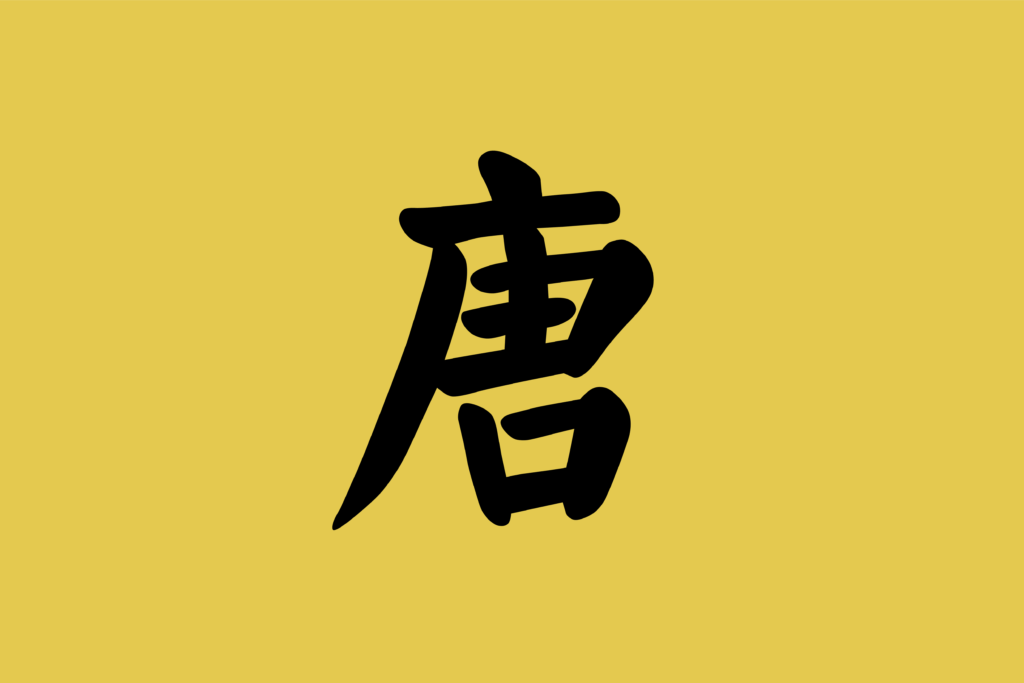
Flag of the Tang Dynasty
The Tang Emperor respected the teachings of Islam and allowed Muslims to practice their faith.
The Traders
Early Muslim settlers constituted a floating rather than a fixed element of the population, coming and going between China and the West by the oversea or the overland routes.
It appears then that the building of the masjids and the presence of Islam in China during this early period was more of a facilitation for Muslim traders traveling through or settling temporarily in China, and this appears to be restricted to Guangzhou in the south east of China.
In the northwest, however, the story was different.
❝
Umayyads ruled the Islamic world in the early 8th century and some fierce military expeditions pit the Muslim armies against those of the Tang empire
Umayyad Battles Against China
Umayyads ruled the Islamic world in the early 8th century and some fierce military expeditions pit the Muslim armies against those of the Tang empire. Muslims had expanded into the lands surrounding China, popularly known in Arabic sources as ma waraa an-nahr (what lies beyond the river) or in Roman sources as Transoxiana (Central Asia that includes Uzbekistan, Tajikistan, Kazakhstan, and Kyrgyzstan).
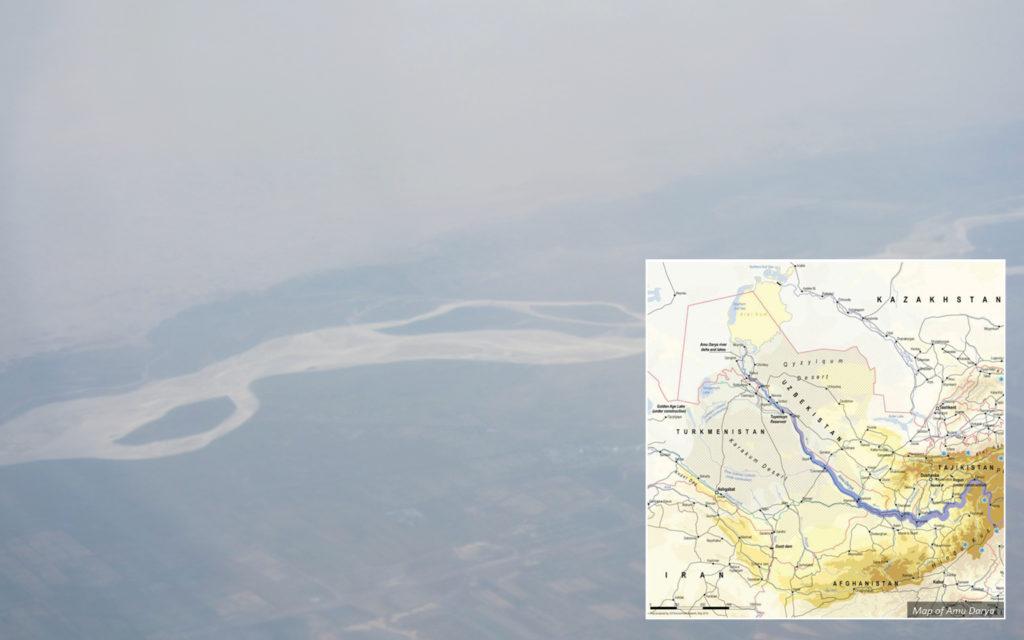
Amu Darya or the Oxus River: In Arabic sources, the fertile land beyond this river was known as ‘maa wa raa an-nahr’
Qutaybah ibn Muslim, an Umayyad general and governor of Khurasan under Caliph al-Walid ibn Abdulmalik, expanded into these territories with successful military campaigns. However, due to internal conflicts after the death of Caliph al-Walid and a rebellion against the caliphate, Qutaybah was killed.
After the death of Qutaybah, Muslim authority weakened in these territories and, with help from the Tang emperor, the previous king who had sought refuge in China recaptured some of these lands.[1]
Nevertheless, by the end of the Umayyad period (750), most of Transoxania – one of the wealthiest lands of the medieval world, thanks to its extensive trade with China largely in silk, and Eastern Europe in such goods as furs, amber, honey, and walrus ivory – had been incorporated into the Islamic realm.
This conquest, however, put the Muslims on a collision course with China, which had made its presence felt in these areas as early as the second century B.C. During the Tang dynasty, commercial and diplomatic links between China and Transoxania were quite strong.
[1] The Fergana Valley, especially, could not be recaptured until the Abbasids came to power.
The Battle of Talas and the Abbasid Victory
Map of the Battle of Talas
❝
It led to the spread of Islam in the region and introduction of Chinese paper-making technology in the Islamic world
The Battle of Talas determined which of the two civilizations, the Chinese or the Muslim, would predominate in Central Asia. It led to the spread of Islam in the region and introduction of Chinese paper-making technology in the Islamic world.
This battle has been covered in both Chinese and Arabic sources. The renowned Muslim historian Ibn al-Athir (1160-1233) and the scholar of hadeeth Imam al-Dhahabi (1274-1348) have covered this battle in their writings.
Curiously, the most outstanding early Muslim historian, al-Tabari (839-923), has nothing to say about the Battle of Talas – indicating perhaps that from the medieval Islamic perspective, the battle seemed a rather unimportant encounter.
What led to the battle was perhaps a petty fight between two local kingdoms: Fergana and Chach. Fergana sought Chinese help and they besieged Chach. Using treachery after promising a safe exit, they executed the ruler, whose son escaped to the Abbasids in Khorasan.
Abu Muslim, the governor of Khorasan, quickly mustered an army along with neighborhood reinforcements and joined the army of Transoxiana under the brilliant commander Ziyad ibn Salih. Ziyad was a former governor of Kufa, Iraq under the Umayyads.
According to Muslim sources, the Chinese had arrived with an army of 100,000 (30,000 according to Chinese sources) near the Talas river. Chinese annals say the fighting lasted for five days, while Arabic records are inconclusive. The result of this epic encounter, however, is unanimously attested: The Muslims utterly destroyed the Chinese army. In the words of Imam al-Dhahabi, “Allah cast terror into the hearts of the Chinese. Victory descended, and the disbelievers were put to flight.”

Imam al-Dhahabi credits the victory to the strategic acumen of Ziyad ibn Salih, while the Chinese blame the Karluk Turks for revolting and changing sides during the battle. However, researchers point out that the Karluks were allied with the Arabs from the start and their positioning to attack the Chinese from the back was part of a strategic battle plan.
Regardless, the victory permanently ended Chinese influence in the region. The Abbasids ruled for the next 400 years and Central Asia has since been predominantly Muslim.
The Tang empire was going through internal rebellion and conflicts in China, which made them retreat and not come back to vie control in Central Asia.

CLEAR YOUR DOUBTS ABOUT ISLAM
By Umm Muhammad
This book provides concise yet comprehensive answers to questions most often raised about Islam and corrects much of the misinformation currently being spread in a clear, logical manner.
Description of Muslims in Tang Manuscripts
Du Huan, a Chinese prisoner taken to Baghdad after the Battle of Talas, gave a good description of Muslims in the 8th century, which was recorded in the Tongdian (801CE)[1]:
❝
“The men have high noses, are dark, and bearded. The women are very fair [white] and when they go out they veil the face. Five times daily they worship God [Tianshen]. They wear silver girdles, with silver knives suspended. They do not drink wine, nor use music… Every seventh day the king sits on high, and speaks to those below saying: ‘Those who are killed by the enemy will be reborn in Heaven above; those who slay the enemy will receive happiness.’”
According to other reports, including one by al-Tabari, when an envoy of Caliph al-Walid visited Emperor Hsuan Tsung in 713CE with presents, he refused to perform the prescribed obeisance, saying: “In my country we only bow to God and never to a prince.” At first, the emperor wanted to kill the envoy. One of the ministers, however, interceded saying that “a difference in the court etiquette of foreign countries ought not to be considered a crime.”
The Tang Emperor Seeks Help from the Abbasids
The An-Shi Rebellion started when a popular Tang general An Lushan, who had fallen out of favor, rebelled against the empire in 755CE. The rebellion and subsequent disorder resulted in a huge loss of life and large-scale destruction.
Despite the loss at the Battle of Talas, it appears there was no enmity between the Tang empire and the Muslims. The emperor reached out to the second Abbasid caliph Abu Ja’far al-Mansur asking for troops to help him recapture the capital Ch’ang-an. The caliph sent 4,000 soldiers who helped retake the capital. The rebellion was finally crushed with the help of the Abbasids. However, it significantly weakened the Tang dynasty.
Flourishing of Muslim-Tang Ties and Trade
The 4,000 troops later settled in China, married Chinese women, and perhaps became the forefathers of native Chinese Muslims.
Trade continued along the Silk Road between the two most important cities in the world at the time: Ch’ang-an, “the City of Eternal Peace,” and Baghdad “Madinat as-Salam,” the “City of Peace.” Both capitals were planned, cosmopolitan cities with a market for foreign goods, laws and regulations for the display and sale of merchandise and sizeable foreign populations: Uyghurs, Turks, Arabs, Persians and Hindus.
Arab interaction with China increased with the advent of land and sea-faring Muslim traders. The sea route to China was of paramount importance as Muslim traders settled in Chinese ports. Muslim traders became highly successful.
According to the Tang Dynasty records, named Zi Zhi Tong Jian (“History as a Mirror”), there were over 4,000 foreign businesses established within the capital of which the majority were Arabian and Persian in origin. In fact, the economic contacts became so intense that the Tang Court at Ch’ang-an had to set up a special trading department to deal with the administration of the successful silk roads.
Mosques were built in Guangzhou (Canton, Khânfû), Quanzhou (Madinat al-Zaitun), Chang’an (Xi’an, Anjû), and Hangzhou (Khânsa), and communities established in many other cities.
Muslims as Minorities
Due to several factors, the descendants of the Muslim soldiers kept to their faith within themselves and grew into the Muslim minorities of North and West China.
In South China, the descendants of Muslim traders remained as close-knit communities and did not intermingle with other ethnicities. Although regarded as a bit strict in discipline, Muslims were fair and most importantly law-abiding citizens. Because of their lack of missionary activity and low political profile, Muslims were not perceived as a threat and therefore tolerated within the Tang empire.
Abu Zaid Hasan al-Sirafi, a 9th century Muslim traveler, reports from a merchant Sulaiman in 850CE that:
“At Guangzhou which is the meeting place of traders, there is a Muslim appointed by the Chinese [authorities] with the power to decide conflicts between Muslims who come here, and this in accord with the particular wish of the Chinese sovereign. During festivals, he leads the Muslim prayers, delivers sermons, and expresses their good wishes for the local authority which rules the Muslims.”
This was also the general attitude of the Tang toward foreigners or religious minorities: allow them to practice and govern themselves by their own laws.
By the late Tang period, we have non-Muslim Chinese descriptions of Muslims living in China, though they do not name them as Muslims. Chinese sources are also aware of the Islamic dietary laws.
The Massacre of Muslims and Other Minorities
In 760 and 878, two massacres took place in port city of Guangzhou by rebels who wanted to overthrow the Tang empire. The first massacre was led by An Lushan, which as mentioned earlier was crushed with the help of the Abbasids.
The second incident, the Guangzhou Massacre, was led by the rebel army of Huang Chao. His troops terrorized the city and targeted the foreign population, which had grown quite wealthy over the years. The rebel forces tapped into popular sentiment that somehow the decline of the Tang fortunes and their own lives had been made worse by the presence of greedy foreigners.
Abu Zaid writes of 120,000 Muslims, Christians, Jews and Magians slaughtered by the rebel forces.
[1] Tongdian is a Chinese institutional history and encyclopedia text written from 766-801
Muslims During the Song Dynasty (960-1279)
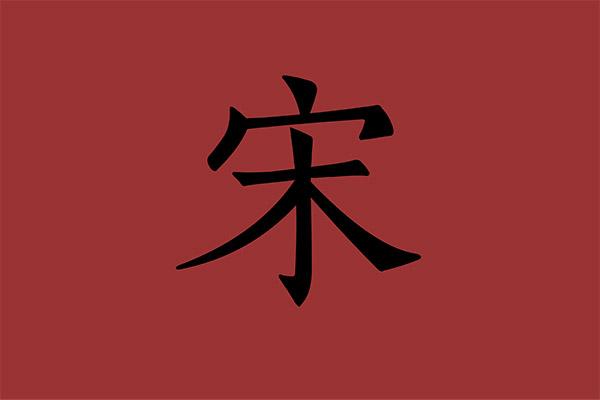
Flag of the Song Dynasty
❝
Muslims in China dominated foreign trade and the import/export industry to the south and west
Trade was booming and many Arab and Persian merchants flocked to Guangzhou where the office of the Director General of Shipping was constantly under Muslim management, due to their law-abidingness and self-disciplined nature.
Abul-Abbas al-Hijazi, a prosperous twelfth-century merchant who spent many years in China, had seven sons whom he posted in seven different commercial centres from his base in Yemen thus establishing a successful trading network after the loss of all but one of his twelve ships in the Indian Ocean.
In 1070, the Song emperor Shen-tsung invited 5,300 Muslim men from Bukhara to settle in China. The emperor sought their help in his campaign against the Liao empire in the northeast. The object was to create a buffer zone between the Chinese and the Liao.
In 1080, 10,000 Arab men and women migrated to China on horseback and settled in different provinces of the north and north-east.
Awareness of Islam spread during this period as Muslims multiplied and became more dominant. Chinese literature mentioning the stories of Ibrahim, Yusuf and Ismaeel were influenced by Islamic sources and not Biblical ones.
Description of Muslims in Song manuscripts
The description of Muslims during the Song dynasty is strikingly similar to the account provided by Abu Zaid in the 9th century.
Referring to 1192, Zhu Yu and Yue Ke describe foreigners living in Guangzhou who have Muslim customs. Zhu Yu writes:
“In the foreign quarter in Guangzhou reside all the people from beyond the seas. A foreign headman [fanzhang] is appointed over them and he has charge of all public matters connected with the quarter. He makes it his special duty to urge the foreign traders to send tribute. When a foreigner commits an offence anywhere, he is sent to Guangzhou, and if the charge is proved he is sent to the foreign quarter [and whipped].”
Zhu Yu also writes:
“Even now foreigners are not just forbidden from eating pork… Even now, foreigners will not eat any of the six domestic animals not slaughtered by their own hand. As for fish and turtles, they eat all.”
The situation for foreigners, in particular Muslims, had hardly changed since the Tang. But by now they were settlers, not aliens. They had mosques in most of the big cities, in Guangzhou, Quanzhou, Xi’an, Hangzhou, Yangzhou; and almost certainly in Kaifeng, Beijing, Ningbo, Dingzhou and elsewhere. There were special Muslim cemeteries in Guangzhou, Quanzhou and Hangzhou.
Song sources also refer to Muslims as “five generation foreign guests.”
THE MONGOLS
Muslims in Yuan Dynasty (1271–1368)
❝
Muslims were ranked above the Chinese, second in status only to the Mongol overlords themselves
With the coming of Mongols, life changed for Muslims in China.
The Mongols transported tens of thousands of artisans and technicians of various kinds from Persia and Central Asia all the way to Mongolia and Beijing in north China. Many Muslims were amongst them. Muslim soldiers also became an important part of the Mongol armies.
It was in the Mongol Yuan period that the largest influx of Muslims occurred. Additionally, a Mongol prince Ananda converted to Islam, together with tens of thousands in the area.
Muslim traders also moved into other parts of China from the port cities of Guangzhou and Quanzhou.
Mongols Divide and Rule
The Mongols organized society into four main classes: Mongols, Semuren (Muslims fell in this category), Hanren (North Chinese) and Nanren (South Chinese).
The Muslims were ranked above the Chinese, second in status only to the Mongol overlords themselves. Several Muslims reached high ranks in the Mongol government. Muslims were officials, military officers, financial advisers, engineers, cartographers and architects, astronomers, physicians and pharmacists, tax collectors, customs officers and trading middlemen.
Chinese Dislike of Muslims
The division into classes appears to be a strategic move of the Mongols to subjugate the local population. At the same time the Mongols imported Central Asian Muslims to serve as administrators in China, the Mongols also sent Han Chinese and Khitans from China to serve as administrators over the Muslim population in Bukhara in Central Asia, using foreigners to curtail the power of the local peoples of both lands.
The Chinese hated them for their support of the Mongols, and for their financial role as tax collectors and trading agents of the Mongols. It is only during this period that we find Chinese sources ascribing racist and derogatory descriptions to Muslims.
Oppression and Rebellion
The Mongols were not always friendly to Muslims. The rulers granted a sort of monopoly to foreigners whom at one and the same time they despised, exploited and protected.
In fact, for a short time (1280-87) the Mongol ruler forbid (halal) ritual slaughter and circumcision for Muslims and Jews. However, because of the damage to trade this produced, this oppression was canceled.
Towards the end of the Mongol Yuan period more restrictions were placed on Muslims, perhaps to win the support of the local Chinese. Persecution and corruption became so severe that top Muslim generals from the Mongol army joined the Han Chinese in rebelling against the Mongols. The Ming founder Zhu Yuanzhang had Muslim generals like Lan Yu who fought and defeated the Mongols in combat.
Ibn Battuta’s Adventurous Journey to China

❝
He ended up at the shores of Calicut with nothing but the clothes he wore and a prayer mat
Ibn Battuta (1304-1369) was a noted explorer and traveler born in Morocco into a family of judges. He studied Islamic theology, but little did his family know when he left at the age of 21 to perform Hajj at Makkah that he would not return to his native town for nearly three decades.
He served as a Qadi (judge) for eight years in the Sultanate of India under Sultan Muhammad Tughlaq (1326-51). The Sultan assigned him a mission to China in 1341 as an ambassador to meet the most powerful ruler in the world, the Mongol Emperor of China.
The life-threatening adventure began just as he left Delhi where he was taken prisoner by Hindu rebels and was hunted for eight days as a fugitive before ending up at the shores of Calicut with nothing but the clothes he wore and a prayer mat. He was blessed to be alive.
He continued his journey to China via the Maldives where he became a chief judge – without the intention of becoming one – and married into the royal family. He then set sail from Sri Lanka when his ship nearly sank in a storm. He was rescued by another ship which was attacked by pirates who stole all his provisions and the precious stones given to him by the King of Ceylon. He again ended up in Calicut with no clothing except his trousers.
He set sail once more, briefly stopping at the Maldives to see his two year old son for the first time, then boarded a ship to China via Chittagong (the main port of Bangladesh) and the Muslim Kingdom of Samudra (Sumatra, Indonesia). He finally arrived at the port of Madinat al-Zaitun (Quanzhou) in 1345.
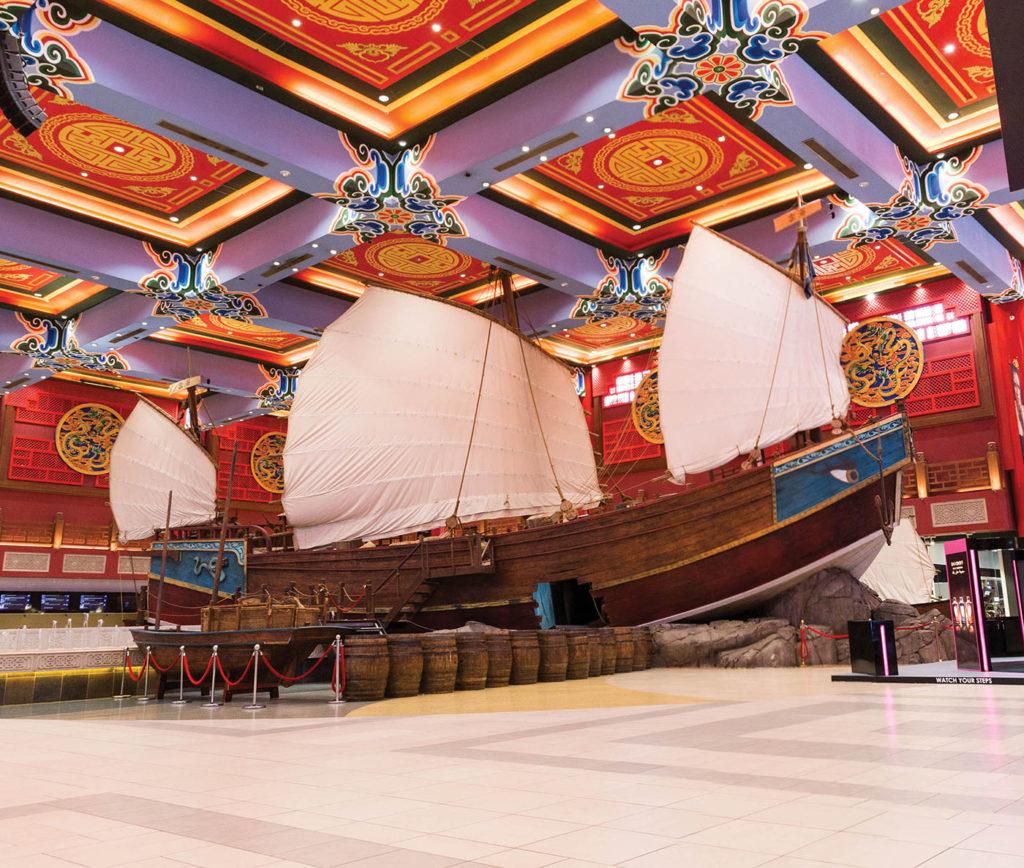
A model of the Chinese junk (ship) Ibn Battuta took on his journey, displayed at Ibn Battuta Mall, Dubai
He described al-Zaitun as housing one of the largest ports in the world with about a hundred junks (Chinese sailing ships) that could not be counted for multitude. Every city had a separate Muslim quarter where merchants and their families lived in an honoured and respected manner with their own mosques, hospitals and bazaars.
The Qadi “Fanzhang” (judge) of the Muslims, who was Sheikh al-Islam and the leader of the merchants, all came to meet Ibn Battuta with flags, drums, trumpets and musicians. He was invited and entertained by some immensely wealthy Muslim merchants. He was well received in every city as guest of honour on his way to Beijing, only to be disappointed to find the Emperor absent from the capital. He returned to al-Zaitun before sailing back to his native land in 1349.
Ibn Battuta had arrived in the last peaceful years before the collapse of the Mongol (Yuan dynasty) rule. He noted, “China is the safest and most agreeable country in the world for the traveler. You can travel all alone across the land for nine months without fear, even if you are carrying much wealth.”
He declared that of all people the Chinese were the most skillful in the arts and possessed greatest mastery of them.
He admired much that he saw. He observed that “silk is used for clothing even by poor monks and beggars” and that the porcelain was “the finest of all makes of pottery.” Even the poultry amazed him: “The hens … in China are … bigger than geese in our country.”
But China was not a Muslim land
Muslims were a minority in China. Unlike Ibn Battuta’s previous destinations, China was not a Muslim country, and he was taken aback by what he saw.
“China was beautiful, but it did not please me. On the contrary, I was greatly troubled thinking about the way paganism dominated this country. Whenever I went out of my lodging, I saw many blameworthy things. That disturbed me so much that I stayed indoors most of the time and only went out when necessary. During my stay in China, whenever I saw any Muslims I always felt as though I were meeting my own family and close kinsmen.”
“The Chinese themselves are infidels who worship idols and burn their dead like the Hindus . . . eat the flesh of swine and dogs, and sell it in their markets.”
THE PEAK
Muslims in Ming Dynasty (1368-1644)

A Two-part glazed pottery ‘dragon’ tile from the Ming Dynasty. Source: Christie’s
❝
[The emperor] wrote a 100-character praise on Islam, Allah and the Prophet Muhammad ﷺ
Perhaps due to their support of the Ming rebellion against the Mongols, Muslims enjoyed special protection and treatment in the Ming empire. Islam and Judaism were respected, but Christianity and Manichaeism were not.
The Emperor Builds Mosques
The founder of the Ming dynasty, Hongwu Emperor, Zhu Yuanzhang, ordered the building of several mosques in southern China, and wrote a 100-character praise on Islam, Allah and the Prophet Muhammad ﷺ. He had over 10 Muslim generals in his military. The Emperor built mosques in his capital Nanjing and in Yunnan, Guangdong and Fujian. Large numbers of Muslims moved to Nanjing during his rule. He ordered that inscriptions praising Muhammad ﷺ be put in mosques.
Integration into Chinese Culture
The Ming dynasty saw a rapid decline in Muslim population in the seaports. This was due to the closing of all seaport trade with the outside world except for rigid government-sanctioned trade.
Many Muslims from Central Asia who were moved to China during the Mongol period settled down and took Chinese surnames. It was during the Ming dynasty that Muslims first adopted and integrated into Chinese culture. Many became fluent in Chinese and adopted Chinese names. The capital, Nanjing, became a center of Islamic learning.
Communities with Ahung (Imam) leaders flourished. Muslims were able to win prestigious degrees to become magistrates and education officials. They still kept their special trades as beef and mutton growers, importers and transporters.
Muslim customs of dress and food went through a synthesis with Chinese culture. The Islamic modes of dress and dietary rules were maintained within a Chinese cultural framework. Chinese Islamic traditions of writing began to develop, including the practice of writing Chinese using the Arabic script (xiaojing) and distinctly Chinese forms of decorative calligraphy. The script is used extensively in mosques in eastern China.
Mosque architecture began to follow traditional Chinese architecture. A good example is the Great Mosque of Xi’an, whose current buildings date from the Ming dynasty. Western Chinese mosques were more likely to incorporate minarets and domes while eastern Chinese mosques were more likely to look like Chinese.

Qingjing Mosque; Top: Outer gate; Bottom: The masjid; Inset: The Emperor’s edict on protection for Islam and Muslims
Forced Ethnic Assimilation
Although Islam was tolerated, the early policy towards ethnic minorities was of integration through forced marriage. After a century of Mongol rule, the Ming wanted to bring back the domination of Han Chinese. Members of other ethnic groups were required by law to intermarry. So, Hui Muslims had to marry Han since they were of different ethnic groups, with the Han often converting to Islam. These regulations, like the ones in the Tang and Song, were soon abrogated or ignored.
Da’wah Activity and Literature
China and the Muslim world had contact in the Ming period. The first written record of Chinese Muslims performing the Hajj is from this period. Some pilgrims left accounts of their difficult journeys in Chinese. The knowledge of the Muslim world is reflected in works as the great Ming geography, which contains relatively precise information about cities, including Makkah and Madinah, some of which may have been gathered on the naval expeditions of Zheng Ho, a Muslim admiral in the service of the Ming.
Islamic propagators continued to visit during this period, perhaps bringing in a variety of beliefs and philosophies.
It was during the Ming Dynasty that many Arabic books – particularly those of a scientific nature – were translated into Chinese. Islamic medicine and astronomy were now influential in China.
Islamic Books in Chinese
Wang Daiyu, a Muslim scholar of Arab descent, wrote perhaps the first original Islamic literature in Chinese. He authored the five-volume True Explanation of the Correct Religion (Zhengjiao Zhenquan)in 1642, two years before the end of the Ming dynasty.
Wang saw the need for Islamic works in Chinese instead of depending solely on Arabic ones. He went on to write Qingzhen Da Xue (The Great Learning of Islam) and Xizhen Zhengda (Rare and True Answers).
Wang, who knew Chinese, Persian and Arabic and had studied Confucianism, used Chinese classical texts to explain Islam. He was critical of Buddhism and Taoism, while citing Confucian ideas which agreed with Islam in order to explain it.
Other authors like Ma Zhu and Liu Zhi also wrote several books on Islam, but sometimes using and mixing Confucian ideas with Islamic teachings.
Muslims During the Qing Dynasty (1644-1912)

Flag of the Qing Dynasty
The period during the Qing dynasty was marked by war, rebellion and conflicts. Muslims split into rival, sometimes ethnic and sectarian, factions depending on whose side of the war they were fighting.
With the fall of the Ming dynasty, there was a power vacuum, and western regions of China were left to themselves. It took some time for the Qing to settle and start retaking the territories under Ming. The Qing were ethnically Manchus, a minority among the Han Chinese.
Introduction of Sufism in China
Afaq Khoja (1626-1694) is generally credited with the influence of Sufism in China. His two spiritual descendants, Ma Laichi and Ma Mingxin, founded the two dominant schools of Chinese Sufism – Khufiyya and Jahriyyah. Another Chinese Sufi master Qi Jingyi, who met Afaq Khoja when he was 16, introduced and spread Qadriyyah in different parts of China.
East Turkestan Falls to Qing
For the first time, in 1759, a Chinese dynasty conquered the land of Uyghurs. The Qing overthrew the Dzungar Khanate to take control of the Tarim Basin where Uyghurs, the Turkic Muslims lived. While we will explore the history of Uyghurs in another article in-sha Allah, it is relevant to mention at this point that the current borders of China are based on the Qing dynasty’s expansions. Although the Mongols also briefly took over these areas, the Mongols were never Chinese. The Qing renamed this territory as the Xinjiang (new territories).
Muslim Rebellions
In the beginning, when Qing had invaded, Muslims loyal to the Ming led a rebellion to drive out the Qing and restore the Ming prince. The rebellion was joined by Han Chinese and Tibetans. The rebellion was ultimately crushed.
A few years after the fall of East Turkestan, the Uyghurs revolted because of – without going into much detail – the corruption and oppression to which the Qing officials subjected them.The oppressing Qing officials included Muslims as well, unfortunately. This revolt was more of a revenge carried out against select individuals. The Qing in response killed the rebels and exiled their women.
The situation did not improve, and Uyghur’s hatred of the Manchu rule grew. Jahangir Khoja from the neighborhood Kokand Khanate attacked and was able to free Kashgar and Yarkand (parts of Xinjiang) from Qing in 1820. With the help of Hui Muslim merchants, the Qing defeated Jahangir and retook the territories in 1828.
In 1781, two rival Sufi groups – Jahriyya and Khafiyya – were involved in sectarian violence. When the fighting did not stop, Qing got involved and imprisoned some of the leaders. The Jahriyya revolted and the Qing, with help from Khafiyya, crushed the Jahriyya.
In 1862, what started as conflicts and riots between Hui Muslims and Han Chinese in some parts of China (excluding Xinjiang), blew out of proportion and turned into a full-scale revolt. The Qing had adopted an approach of segregation and division to be able to rule over the different ethnicities, because the Qing themselves were an ethnic minority ruling of a majority of Han Chinese and others. This revolt, called as the Dungan revolt, was mostly led by Hui Muslims but it was not of a religious nature. The revolt had no clear objective and it was more of a riot against the frustrations some of the people felt under Qing rule. Hui Muslims living in unaffected parts of China were not touched by the revolt.
While the Qing were distracted by the Hui rebels, Yaqub Beg, who had fled from the Kokand Khanate managed to take full control of Xinjiang. Yaqub Beg, who ruled for 10 years, was not particularly noble either. He slaughtered many local Uyghurs and kept them out of his administration.
The Qing, with the help of several Muslim generals and armies, crushed the revolt and reconquered Xinjiang. General Ma Anliang led an entire army composed of Chinese Muslim troops against Yaqub Beg’s Turkic Muslim forces and defeated him, reconquering Turkestan for China.
Ma Anliang led Hui cavalry troops in the slaughter of rebel Salar Muslim fighters, who had agreed to negotiate unarmed at a banquet. He lied to them, saying, “Disown me as a Muslim if I deceive you.” Although he was a Muslim, he showed no mercy to those Muslims who had rebelled against the Qing government.
❝
The current Chinese government considers Du Wenxiu a national hero
Islamic Kingdom of Yunnan
Du Wenxiu, a Han Chinese whose family had embraced Islam, led a massive revolt against the Qing. He took over the city of Dali in western Yunnan in 1856 and proclaimed it the “Islamic Kingdom of Yunnan.” He held it until it fell in 1872.
Du’s Muslim name was Sulayman ibn `Abd ar-Rahman. He took the title of Qa’id Jami al-Muslimin (Leader of the Community of Muslims), but the title generally used was ‘Sultan.’ He wore Chinese clothing, mandated the usage of Arabic language, and banned pork. The Sultanate reached its peak in 1860 and enjoyed its zenith for the next eight years. During this time, Sultan Sulayman made pilgrimage to Makkah.
Du Wenxiu (Sulayman) used anti-Manchu rhetoric in his rebellion, calling for Han to join the Hui to overthrow the Manchu Qing. He called for unity between Muslim Hui and Han and was quoted as saying, “our army has three tasks: to drive out the Manchus, unite with the Chinese, and drive out traitors.” He did not blame the Han for ethnic conflicts, but blamed the Manchu rulers, saying that they were foreign to China and alienated the Chinese and other minorities. He called for the complete expulsion of Manchus from all of China in order for China to once again come under Chinese rule.
By 1871, the Qing had reinvigorated and planned to attack Yunnan. Another Muslim leader, Ma Rulong who had rebelled along with Du Wenxiu, had surrendered and defected to Qing. He played a critical role in fighting and defeating Du Wenxiu. Ma Dexin, a Muslim scholar, claimed that Neo-Confucianism was compatible with Islam and allowed Ma Rulong to defect and fight Du Wenxiu. Under Qing, Ma Rulong and his forces almost entirely took control of Yunnan. With the help of French support and advanced artillery, Du Wenxiu’s kingdom fell to the Qing.
The current Communist Party of China regards the Qing as foreign and Du Wenxiu as a national hero.
Muslims in the Republic of China (1911-1949)

In 1911, the Chinese Revolution overthrew the Qing, the last imperial dynasty of China, and established the Republic of China. The first president, of the Kuomintang party, declared that the country belonged equally to the Han, Hui (Muslim), Meng (Mongol), and the Tsang (Tibetan) peoples. This improved ethnic relations in the country.
The Muslim community started rebuilding what was destroyed during the Qing period. The interaction of Muslims in China with the Muslim World also increased. By 1939, at least 33 Hui Muslims had studied at Cairo’s Al-Azhar University. Academic activities within the Muslim community also flourished. Before the Sino-Japanese War of 1937, there existed more than a hundred known Muslim periodicals. Thirty journals were published between 1911 and 1937.
Muslims served extensively in the National Revolutionary Army and reached positions of importance, like General Bai Chongxi, who became Defence Minister of the Republic of China.
The Warlord Era
During the end of its dynasty, the Qing was forced to allow provincial governors to raise their own armies. This continued in the beginning period of the Republic of China. The country was divided among military cliques and other regional factions. Muslim warlords and generals were quite powerful and played an instrumental role in the fight against the Japanese invasion in the 1930s.

Conference of Muslim leaders, 1912. Ma Anliang (front row centre) was the most powerful of the Muslim leaders at the time of the conference.
Second Sino-Japanese War
In 1937, after a few years of skirmishes, Japan conquered Beijing, Shanghai, and the then Chinese capital Nanjing. The Japanese continued on a killing rampage, especially against Muslims. About 220 mosques were destroyed and countless Hui Muslims were killed. The Hui Muslim county of Dachang was subjected to slaughter by the Japanese.
❝
Muslim leaders went to the Middle East to gain backing for China
The Japanese tried to win Muslim support in the war by promising liberation and self-determination. However, Muslims did not join the Japanese and fought fiercely against the invasion. Several prominent Muslim generals played a critical role in fighting off the Japanese. Jihad was declared as obligatory by Chinese Muslims and many imams made preaching Chinese nationalism mandatory in mosques.
Imam Du Pusheng and other Muslim leaders traveled to the Middle East and other Muslim countries to gain backing for China and refute the misinformation of Japanese agents.
Japan had also by its attack on Pearl Harbour declared war on the United States. With support from the US and Russia, China defeated the Japanese and Japan formally surrendered on September 2, 1945.
East Turkestan
The stirrings of Uyghur separatism during the early 20th century were greatly influenced by the modern reform movements popular in Turkey, Russia and other parts of Europe. The birth of the Soviet Union also influenced the Uyghurs, increasing the popularity of nationalist separatist movements and the spread of the communist message.
The double taxation and oppression of the Uyghurs by the Xinjiang governor also added fuel to the fire. All these issues led to a rebellion and forming of the First Islamic Republic of East Turkestan in 1933. The original proclamation of the state was not only against the Han Chinese, but also very much against Hui Muslims who were considered foreigners.
The state did not last long as in 1934 Hui Muslim generals attacked and reconquered the territory for China.
A second East Turkestan was established with the help of Soviets in the 1940s, which also did not last more than a few years (1944-1949).
Chinese Civil War and the Muslim Role
The Civil War was fought between the ruling Kuomintang party of the Republic of China and the Communist Party. The first insurgencies of the Communist Party started in 1927 and continued till the Japanese war broke out in 1937. After that, the Civil War resurfaced in 1946. The Communist Party reached out to the Muslims for support promising religious freedom and relative independence in return. However, the promises were not honored for very long.
Muslims in the People’s Republic of China
(After 1949)
❝
The promise of religious freedom did not last… even common utterances, such as in-sha Allah and alhamdulillah, could cause Muslims to be imprisoned
Founded by Mao Zedong of the Chinese Communist Party in 1949, the People’s Republic of China went through tremendous upheavals in the early years which culminated in the Cultural Revolution. The promise of religious freedom did not last, and Islam, like all other religions, was persecuted. Mosques were attacked and religious practice was restricted. Mao was a dictator who eliminated anyone who disagreed with his policies.
Oppression During the Cultural Revolution
During the Cultural Revolution (1966-1976), Muslims of China found their religion outlawed and their religious leaders persecuted, imprisoned and killed.
All worship and religious education was forbidden, and even simple common utterances, such as in-sha Allah and alhamdulillah, could cause Muslims to be harassed, imprisoned, tortured, and in extreme cases, killed. Despite the danger, Muslims in many parts of China continued their religious studies in secret.
Mosques, as the centers of communities, were targeted by the state. Local officials throughout the country took control of mosques, appropriating their buildings and land and turning them into factories, storage areas, barns, and schools. Many were simply destroyed. In addition, deliberate efforts were made by local officials to defile the mosques and their adjacent land. For example, mosques were used to accommodate pigs, while pig bones and carcasses were thrown down the drinking wells in mosque courtyards to permanently pollute them.
Shadian Massacre
The most extreme example of state-sponsored violence against Muslims during the Cultural Revolution took place in July 1975, when Shadian, a Muslim village in Yunnan province, was completely destroyed. What happened in Shadian was so extreme that in 1979 the government officially apologized and provided compensation to the surviving residents.
Islamic Revival and Activism
When Mao died in 1976, Deng Xiaoping became the leader of the Communist Party and initiated economic and social reforms. New legislation gave all minorities the freedom to use their own spoken and written languages, to develop their own culture and education and to practice their religion.
In the years immediately after the Cultural Revolution, Muslims of China lost no time in rebuilding their devastated communities. Throughout China, Muslims slowly began to restore their religious institutions and revive their religious activities. Their first priority was to rebuild their damaged mosques. Once communities were able to pray together again, the next priority was to organize Islamic Studies classes.

Muslim children going to the evening madrasah.
As early as the 1980s, some mosques began to organize classes for girls, boys, and young adults, as well as for the older men and women of their communities who had not had the opportunity to study their religion. Beginning in the early 1990s, independent Islamic colleges were also established throughout most of China, except for Xinjiang. These schools offered a full curriculum, including classes on the Qur’an, hadith, tafsir, fiqh, Islamic history, the history of Islam in China, Arabic grammar, and Chinese language.
Many graduates from these colleges go on to teach in smaller schools and establish new schools in different regions.
A growing number have also continued their Islamic studies overseas. Hundreds, if not thousands, of students have studied in Egypt, Saudi Arabia, Syria, Pakistan, Iran, Turkey, and Malaysia. Those who return to China bring back an awareness of the world and a strong foundation in Islamic studies.
Although many hope to immediately take up positions as imams in their home towns and villages, it is often the case that the religious leaders of the community, although impressed with their foreign training, want to make sure the future imams have also acquired an understanding of their own communities and their needs.
In Pictures:
Muslims in China

Mosques
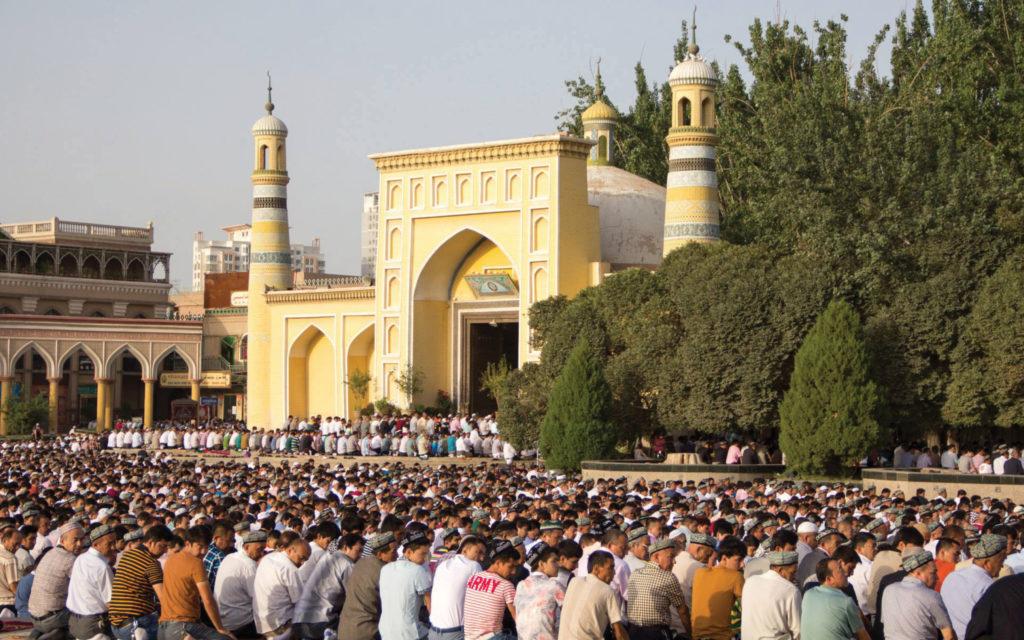
Id Kah Mosque in Kashgar, Xinjiang province, China
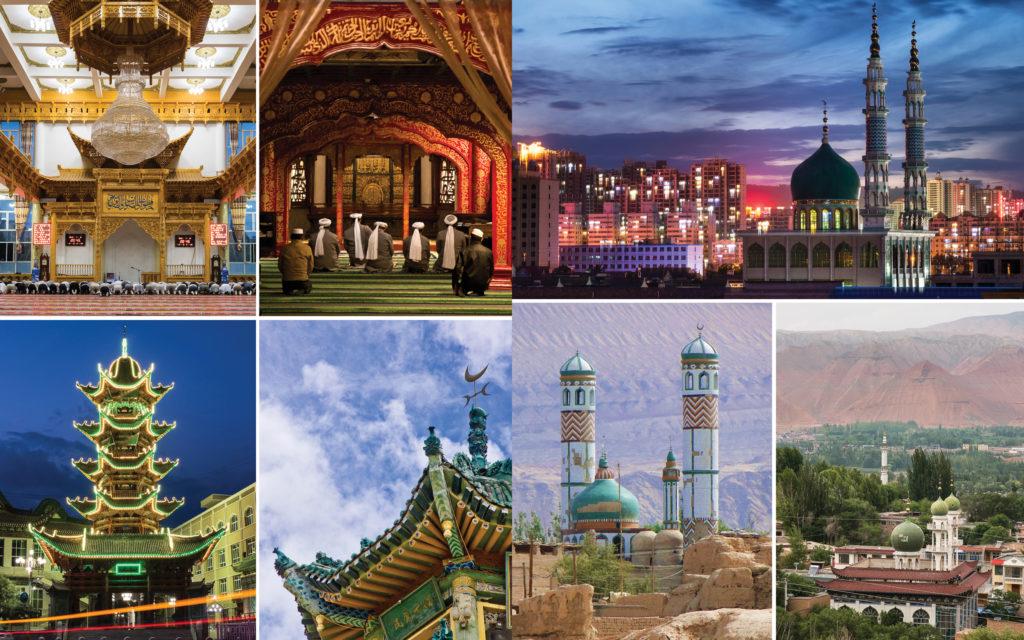
Various mosques around China

Amin Mosque, Turfan, China

Various mosques in China
Chinese Islamic Calligraphy


99 Names of Allah. Right: Close up
Over many centuries of integration, Muslims in China developed a unique calligraphy style: an Arabic script with Chinese characteristics.
Left: The shahada written inside the Lighthouse mosque. Right: The basmalah in the Qingjing mosque.
The Muslim Quarter of Xian
The Muslim Quarter of Xian is a halal food and commercial street that is well-known and famous throughout China. The Muslim Quarter traces its history to the Tang Dynasty over 1300 years ago.
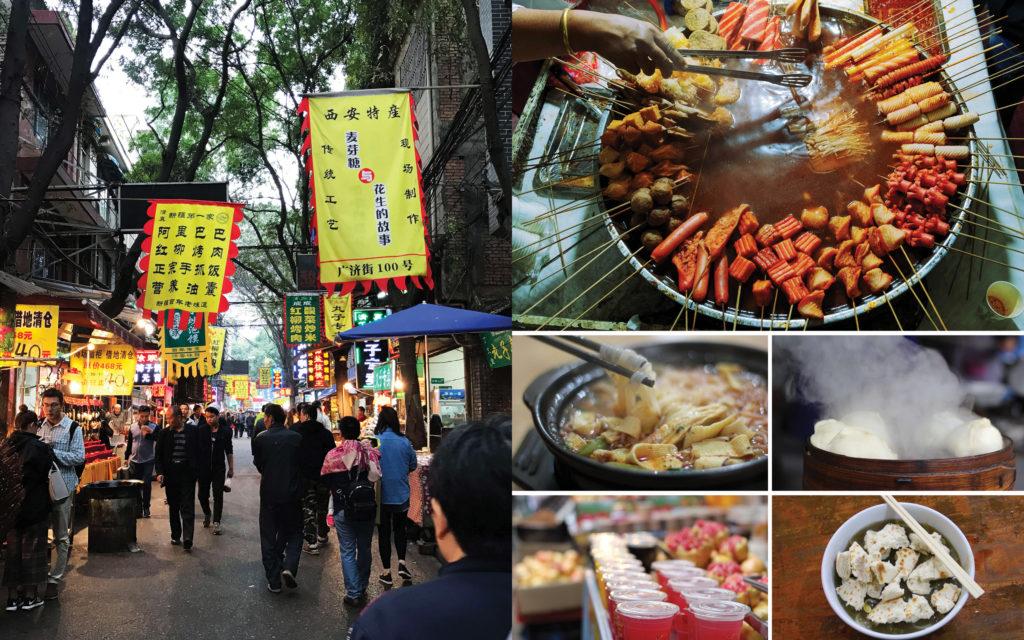
Left: The Muslim Quarter street; Right: Delicious halal food including noodles, dumplings, kebabs, and more.

A Muslim vendor selling the famous “keebabs”

The International Grand Bazaar of Urumqi, Xinjiang Province

Shops and vendors at the Grand Bazaar and the Muslim Quarter

RECIPES:
Uyghur Kebab and Naan
Uyghur “keebabs” are sought after in China as a street food of choice. Originating in Xinjiang, these kebabs have bridged political, ethnic and culinary differences across China.
Uyghur kebabs are a staple of Xinjiang cuisine, and consist of alternating pieces of seasoned lamb meat and fat cut into medium-sized chunks and marinated in traditional spices (usually a closely guarded secret) and then grilled over wood. They are best eaten with traditional ‘naan’ Uyghur bread.
China’s Hui and Uyghur communities are distinguished by their language and the hats they wear – the Huis typically wear white skullcaps, while the Uyghurs wear a square black and green ‘doppa’ – but both are united in their love for Uyghur kebabs, like most mainland Chinese.
The diet in Xinjiang is mainly dependent on (halaal) meat and these traditional kebabs are so popular that Kudret Yakup, the first Uyghur graduate of Harvard College, opened Kebab Empire in New York, the first Uyghur franchise in America.
KEBAB
Ingredients
- 1 lb of boneless lamb leg or shoulder, cut into approximately 1 inch squares (with fat)
- 1 Onion
- 2 tbsps of vegetable oil
- ¼ cup pomegranate juice
- 1 tsp salt
- 1 tsp of freshly ground black pepper
- 2-3 cloves of garlic, minced
- ¾ tsp of cayenne pepper
- 1 tbsp of sea salt
- 1 tsp of ground cumin
Instructions
1. Make the marinade: Add onion, pomegranate juice, garlic, oil, salt and pepper and blend. Add the chunks of lamb in a bowl and cover with the marinade. Cover the bowl with plastic wrap and set in the refrigerator for at least 2 hours to marinate.
2. Soak bamboo skewers in water for 30 minutes (with a heavy plate or spoon on top to prevent floating).
3. Preheat the grill to medium-high. Skewer the pieces of meat onto the skewers, leaving enough space between them so the meat browns. Place the kebabs on the hot grill.
4. Grill for about 2 minutes on the first side then turn, cooking for 7-8 minutes more, turning the skewers so they get good even color.
5. Combine the salt and cumin together. Cook the meat to your liking and sprinkle the cumin-salt immediately after it comes off the grill.
NAAN
Ingredients
- Flour (all purpose or bread flour, both give different results)
- Egg (optional)
- Warm water. Ratio of flour to water by volume: 3 to 1. By weight: 1.5:1.
- Yeast
- Salt
- Sugar
Directions
1. Place flour in a large bowl, pour warm water into the middle.
2. Add half a packet of dry yeast and a bit of sugar. Mix well and let stand for a few minutes. When frothy, add the salt and the egg. Then mix everything, adding water as needed to a smooth consistency.
2. When everything is well mixed, flour a surface and knead the dough for 10 minutes until it no longer sticks to your hands.
3. Lightly oil a bowl and put the kneaded dough ball in, cover with a cloth and let rest for at least 40 minutes in a warm place.
4. When the dough has finished resting, knead it a bit more.
5. Roll the dough out into a round, flat circle. It should not be too thick or too thin. (If it’s too thin, it will burn when you bake, and if it is too thick it will remain uncooked.)
6. Form an edge all around the bread.
7. Take a bread stamp and make concentric patterns all around the center, making sure to press hard so the spikes go all the way through. Alternatively, you can use any round object to stamp around the center. Then use a fork to poke holes, poking all the way through the center to prevent it from rising.
8. Lightly brush oil all over the top and sides of the bread and top with sesame and black seeds (nigella).
10. Ready to bake. Put the dough into your 500F preheated oven and bake until the bread is golden brown all over (10-15 minutes). Lightly brush the bread with oil after it is baked.
The Diverse Muslim Ethnicities of China
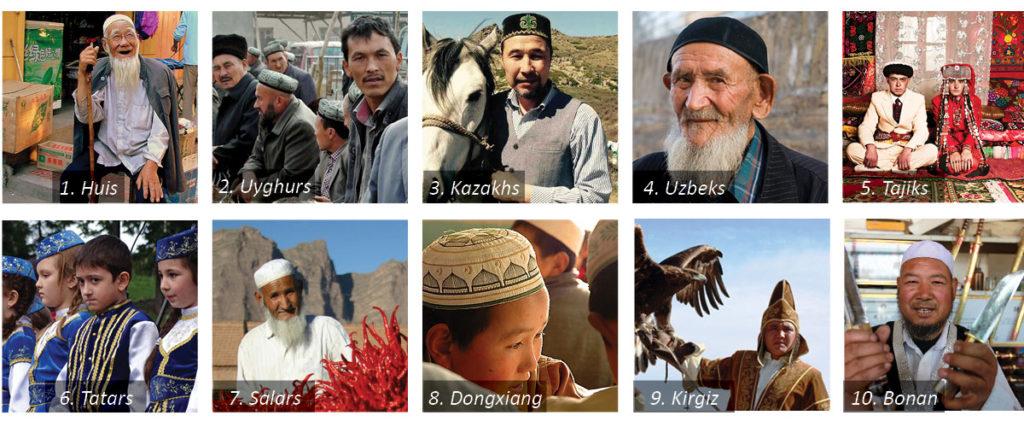
Muslims in China are all identified through their government-assigned ethnicity and not through any means of personally stated religious belief. There are several consequences of this policy. For example, there is no way to identify in the national census the growing number of converts to Islam.
Officially, there are 10 Muslim ethnicities living in China. They are listed below. The largest populations among them are the Huis and the Uyghurs.
1. Huis: Chinese-speaking Muslims dispersed throughout the country. They are about 20 million in population.
2. Uyghurs: A Turkic-speaking group originating from and culturally affiliated with the general region of Central and East Asia. They live mostly in the Xinjiang Uyghur Autonomous Region and are close to 11 million in number.
3. Kazakhs: A Turkic group, they are about 1.4 million and live mostly in Kazakh autonomous counties and regions.
4. Uzbeks: Though they mostly live in Uzbekistan, Uzbeks are also a minority group in several other countries including China. They number about 21,000 in China.
5. Tajiks: A Persian-speaking Muslim group living in Western China around the snow-capped Pamirs, a mountain range shared with Tajikistan and Afghanistan. They are about 51,000 in number.
6. Tatars: They are only about 5000 in number and have their own language.
7. Salars: A Turkic ethnic group with their own language, Salars were about 130,000, according to the 2010 government census.
8. Dongxiang: Closely related to Mongols, they are over 600,000 in number. They are mainly farmers and also craftsmen of traditional carpets.
9. Kirgiz: Another Turkic group that lives in Xinjiang and are about 160,000 in number.
10. Bonan: A small group of about 17,000, comprising a mixture of Mongols, Hui, Han Chinese and Tibetans.
Khalkas: Ethnically they are Mongols (and therefore not counted among Chinese Muslim ethnicities). However, they are Muslims and a small minority living in Inner Mongolia, Qinghai and Jehol.
Challenges Muslims face in China

Muslims in general (other than the Uyghurs, who are enduring extreme oppression) face a number of challenges in China. These include:
State Control of Religion
Establishing civil society organizations is particularly daunting because technically any organization involving Muslims must be established through the auspices of state-controlled organizations. These organizations, staffed by Communist Party cadres, are able to control almost all aspects of public religious activity. The state indirectly has the final say in the appointment of imams and, for the several government Islamic colleges spread around the country, the selection of curriculum, teachers and students to be admitted. Muslim students hoping to travel abroad to continue their studies must first receive permission from the bureau, as must those planning to go on Hajj.
Hajj Restrictions
The issue of Hajj continues to be one of the most serious grievances of Muslims in China against the constraints placed on them by the Chinese state. Beginning in the 1980s, Muslims in China were once again allowed to go on the annual Hajj pilgrimage. According to official numbers, every year approximately 2,000 Muslims take part in the government-sponsored pilgrimage.
❝
One of the criteria for Hajj is that the candidate must be ‘patriotic’ and have ‘good conduct’
However, the state has instituted severe restrictions: for example, pilgrims must be at least sixty years old and not traveling with their spouse. Also, the official quota of 2,000 per year is much lower than the usual Saudi calculation of 1,000 pilgrims for every 1 million of a country’s Muslim population. In China’s case, that should result in a quota of at least 20,000. Some Muslims who already have passports are able to make the pilgrimage independently, or travel via a third country, but for the vast majority of Muslims in China, the possibility of making the Hajj remains distant.
In 2004, reports surfaced that China has loosened some of the restrictions regarding age, and although the official quota remained 2,000 according to Chinese government reports in January 2006, an estimated 7,000 Chinese Muslims took part in the Hajj. It appears that many, if not most of these pilgrims obtained their visas from neighboring countries such as Pakistan and Thailand.
Now, in October 2020, new regulations were released that criminalize private Hajj pilgrimage. Chinese Muslims must only use the government-run service. Next, the state will decide who will go. One of the criteria is that the candidate must be “patriotic” and have “good conduct.” Those who have already performed Hajj will not be able to do again.
Lack of Waqf Foundations
Although in the past there is evidence that Muslim communities actively supported waqf foundations, in the present period this has not been possible.
At the beginning of Communist rule in China, land and later all businesses were nationalized. And although recently there has been a land reform process by which individuals have been given limited ownership over property and business, to what extent this ownership can be passed on is not clear.
Loss of Muslim Neighborhoods
The loss of Muslim neighborhoods in urban areas has been devastating to Muslim communities.
When government city planners decide to tear down old neighborhoods, residents who can prove ownership of their homes are usually assigned public housing in developments on the edge of the city. In the case of Muslim neighborhoods, residents were promised that their communities would remain intact and they would receive adjacent public housing assignments. However, in numerous cases, once the neighborhoods were destroyed and public housing project assignments subsequently issued, these promises were not kept.
❝
…in numerous cases, once the neighborhoods were destroyed… promises were not kept
For example, in Kunming, of the five traditional Muslim neighborhoods that had existed for centuries only two remain, and both are a small fraction of their original size and growing smaller every year. The residents of the neighborhoods destroyed since 1990 have found themselves indiscriminately scattered throughout the public housing projects; not only are they now living far away from their mosques and markets, but also widely separated, with no Muslim neighbors and no means of community support.
How Muslims Are Organizing Themselves
In response to this strict government control, Muslim communities throughout China have established informal civil society projects that seek to support those communities most in need. As Muslims volunteered to spread Islamic education in different parts of China, informal networks to connect Muslim communities throughout China were established. This network has ensured that there is a constant redistribution of resources among different communities.
Large mosques and Islamic schools are the most common sources of funding for both individuals and communities in need. But in addition, beginning in the 1990s, more and more individual Muslims who have become very wealthy have developed their own methods of contributing to the welfare of the Muslim community as a whole. Most of these projects focus on education, from preschool to university programs, but there are also projects to develop Muslim orphanages and nursing homes.
Muslim communities place much emphasis on education, both secular and religious. Consequently, Muslims in several regions are overrepresented among teachers, professors, and college graduates.
Within China, when asked how to explain the recent resurgence in Islamic education, community members cite two main reasons: a desire to rebuild what was taken from them, and the hope that a strong religious faith will help protect Muslims in the future.
How Chinese Muslim Women Are Protected
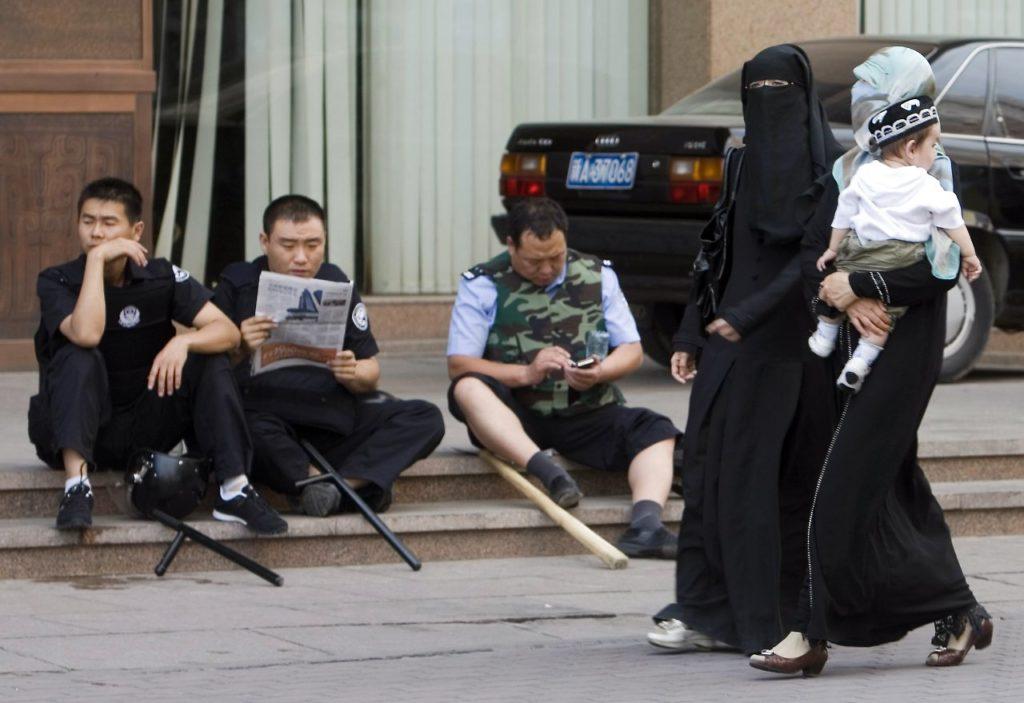
❝
Currently about 24 million Chinese men will not find wives
China is one of the few countries where there is a huge shortage of women. The implementation of the one child policy in 1979 led to millions of baby girls being killed or aborted. As parents are completely dependent on the support of their sons when they grow old, many families choose to abort females. Currently about 24 million Chinese men will not find wives.
This shortage has led to several social problems like forced prostitution and kidnapping and selling women to men who forcefully make them their wives. Consequently, more women than men commit suicide in China.
Although Muslim women in rural areas of China face many of these challenges, Islam has protected them from some of the worst dangers facing others. To begin with, Chinese Muslims do not practice female infanticide because of the Islamic prohibition and the negative affiliation of female infanticide with the jahaliyyah period.
Therefore, Muslim communities are not suffering the serious shortage of women experienced by Han Chinese communities. Prostitution, while common in most areas of China, is relatively uncommon in Muslim communities. Also, as Muslim women appear to be less likely to travel alone to distant cities in search of jobs, they are less vulnerable to being kidnapped and trafficked or forced into prostitution.
Finally, in some regions of China, Muslims take special pride in their daughters, and one of the ways they define themselves vis-a-vis the Han Chinese is that they see themselves as a community which respects women, whereas Han are characterized as having a “zhong nan, qing nu” attitude, or one that favors men and belittles women.
Throughout China, Muslim women are playing an active role in the revival of Islamic education, as both teachers and students. Young women attend Islamic schools and colleges, many of which are designated for women only. There are also mosques solely for women where they pray and learn.

Did Islamic Education Radicalize Chinese Muslims?
Jackie Armijo, assistant professor at New York University Shanghai, has conducted extensive research on the subject and shown that Islamic education did not radicalize Chinese Muslims
Over the past twenty years, throughout all of China (except for Xinjiang), mosques have organized classes in Arabic and Islamic studies for all members of their community, from three-year olds in pre-school programs to eighty-year old retirees determined to study the Qur’an and learn about their faith in their twilight years.
In addition to government-run Islamic colleges, communities have also established independent schools. Increasing numbers of Chinese Muslim students have chosen to go abroad to continue their Islamic studies. At present the most popular destinations are Egypt, Saudi Arabia, Syria, Iran, Pakistan and Malaysia, but there are also students who have traveled to Turkey, Sudan, Libya and Kuwait. As more and more students complete their studies in China and those studying overseas return, there are increasingly more qualified teachers available to establish schools in areas where Islam has not been taught for decades, if not generations.
Based on dozens of interviews carried out between 2005 and 2006 with Chinese Muslim students and leaders throughout China as well as those studying in Egypt, Syria, Saudi Arabia, Malaysia and Pakistan, Jackie maintains in her research that the revival of Islamic education has not resulted in radicalization of Muslims in China.
Instead, the revival of Islamic education has offered Muslims the opportunity to rebuild their faith and their religious institutions in the aftermath of the state-sponsored attacks on Islam during the Cultural Revolution. It has also allowed Muslims throughout China, even in the most remote villages, to gain access to information about issues facing not only Muslims in nearby villages, but also those in distant regions of China, as well as the world.
Understanding the Uyghur conflict
Throughout history, Uyghurs have mostly been independent and therefore some sentiments for a separate state exist in the region. Uyghurs are Turkic in origin – different ethnically, culturally and linguistically – and have lived under a Muslim state since they converted to Islam many centuries ago. Hui people on the other hand are Muslims who are ethnically undistinguishable from the majority Han Chinese.
Uyghur vs Hui
In history, Hui Muslims have been loyal to the Chinese rule and in fact many times fought against the Uyghurs on the government’s behalf. Thus Uyghurs and Hui, despite being Muslims, do not get along well and each stay in their own communities and even pray in their own mosques. However, such sentiments have lessened as Muslims of different ethnicities are increasingly binding together as one community.
While the Chinese government targets the Uyghurs with repressive laws, the Hui are left untouched, although recent reports suggest the Chinese government is extending its restrictive laws on Islamic practice to the Hui as well. But Uyghurs have always been viewed with suspect.
International Politics
The problem is amplified due to international politics as superpowers battle for influence and dominance. The United States has been funding and supporting the Uyghur separatist movement for decades. It is hard to believe that the US can be helping selflessly or in the best interest of the Uyghur people.
In recent decades, abundant oil and mineral reserves have been found in Xinjiang and it is currently China’s largest natural gas-producing region.
❝
Fasting in Ramadan is reported as ‘extremist’ behavior to the government
Abuse of ‘the War on Terror’
In the immediate aftermath of 9/11 and the “war on terror,” the Chinese government lost no time in further restricting the lives of Muslims in Xinjiang. Claiming extensive ties existed between separatist groups in Xinjiang and international terrorist networks, China used their support of the “war on terror” as justification for a widespread attack on all forms of popular resistance to state policies in Xinjiang.
In a November 2001 visit to China, United Nations High Commissioner for Human Rights Mary Robinson warned China not to use the American-led campaign against terrorism as a pretext to suppress ethnic minority groups. Unfortunately, China did not heed those warnings.
Separatist Movements
The tiny separatist movements have not been Islamic – they were either secular, communist, or more recently, “al-Qaeda” in nature, none of which are reflective of mainstream Muslims. This calls to question the integrity and validity of these movements.
Due to some al-Qaeda-style attacks between 2007-2015, China has brought in draconian measures to fight what it says are three evils: “separatism, terrorism, and religious extremism.”
China’s Extreme Measures
The state has conflated the practice of Islam with separatist activity and completely overreacted in illegally prohibiting almost all forms of Islamic education and public religious practice. Thousands of Uyghurs in Xinjiang have been thrown in jail and sentenced without public trial. An untold number have been executed upon being accused of political crimes.
China has also implemented extreme methods of assimilation, which many see as an ethnocide: the deliberate and systematic destruction of the culture of an ethnic group. What is even more disturbing is the coercing to adopt communist ideology and abandon Islam and Islamic practices and appearances.
Putting them through re-educational camps, Uyghurs are made to sing praises of the Communist Party. Mosques have been destroyed, fasting in Ramadan is reported as “extremist” behavior to the government, parents cannot name their children Muhammad, women have been forcefully sterilized, and more.
Although Muslims throughout China face a diversity of challenges and are the subject of a wide range of discriminatory actions, the situation for the indigenous peoples of Xinjiang is unprecedented in its severity, surpassing even the repressive policies facing the Tibetans.
There are also reports that the wealth produced from Xinjiang’s resources is mostly enjoyed by the Han and not the Uyghurs.
❝
One day I heard him speak on the phone while being unusually overjoyed and loud…
Uyghurs Seek Rights, Not Independence
Although there are numerous reports made by the Chinese state and often repeated in the Western press that radical separatism is a common desire in Xinjiang, in fact, the overwhelming majority of Uyghurs in Xinjiang, while not uncritical of China’s policies, are resigned to the reality of Chinese rule. The small number of violent protests are resented by most and seen as adding to the state’s further justification of political crackdowns and control.
Uyghurs speak with increasing despair of their desire simply to be allowed to practice their religion, continue to use their language in their studies, and uphold their traditional cultural practices, as citizens of China.
The Way Forward
If history is any proof, allowing people the freedom to practice their religion has resulted in the state and society flourishing, while oppressive tactics have only brought conflicts, violence and the downfall of empires. It is impossible to force people to accept a state’s views.
It is important that Muslims and Muslim leaders deter China from implementing its extreme approach. The Communist Party must not forget the important role Muslims have played in critical times of Chinese history and the promise it made before coming to power. If China is concerned about separatism (although the Uyghur sentiment has its own merit), it can be handled in an easier and more humane manner without curtailing religious freedom.
Muslims have lived as peaceful, law-abiding minorities in China for over a thousand years, and Muslims continue to live as minorities in many countries where they are free to practice Islam. There is no need to compromise Islam because the spread of true Islamic knowledge serves to eliminate terrorism.
References
- Khamouch, M. (2005). Jewel of Chinese Muslim’s Heritage. Foundation for Science Technology and Civilisation.
- Hoberman, B. (1982, September/October). The Battle of Talas. Retrieved December 02, 2020, from https://archive.aramcoworld.com/issue/198205/the.battle.of.talas.htm
- Leslie, Donald. (2006). The Integration of Religious Minorities in China: The Case of Chinese Muslims. esocialsciences.com, Working Papers.
- ‘T’ang shu, Bk. 221, as quoted by Abel Remusat, Milanges Asiatiques, I. 44I. E.
- Bretschneider, On the Knowledge of Ancient Chinese of the Arabs, etc., 8; quoted by Diplomatic Missions to the Court of China: The Kotow Question I; Author(s): William Woodville Rockhill; Source: The American Historical Review , Apr., 1897, Vol. 2, No. 3 (Apr., 1897), pp. 427-442; Published by: Oxford University Press on behalf of the American Historical Association
- Armijo, J. (2008). Islam in China. In Asian Islam in the 21st Century (pp. 197-228). Oxford University Press.
- Weil, D. (2016). Islamicated China: China’s Participation in the Islamicate Book Culture during the Seventeenth and Eighteenth Centuries. Brill.
- Ke, W. (2017). Between the “Ummah” and “China”: The Qing Dynasty’s Rule over Uyghur Society in Xinjiang. Journal of Intercultural Studies, 48, 183-218.
INCREASE YOUR KNOWLEDGE


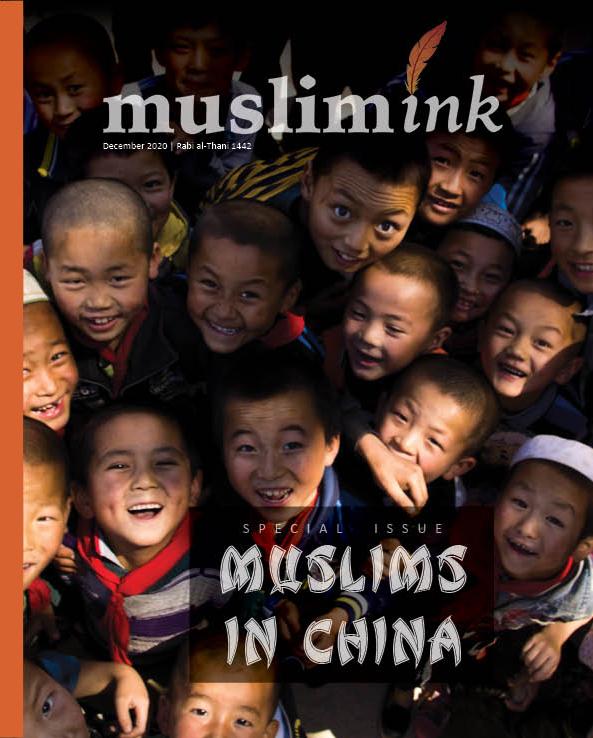



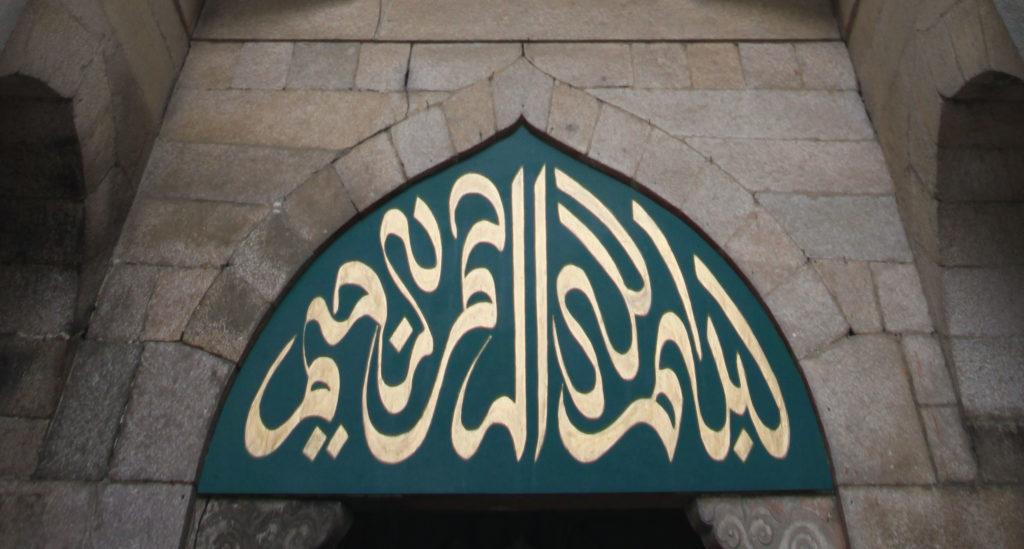
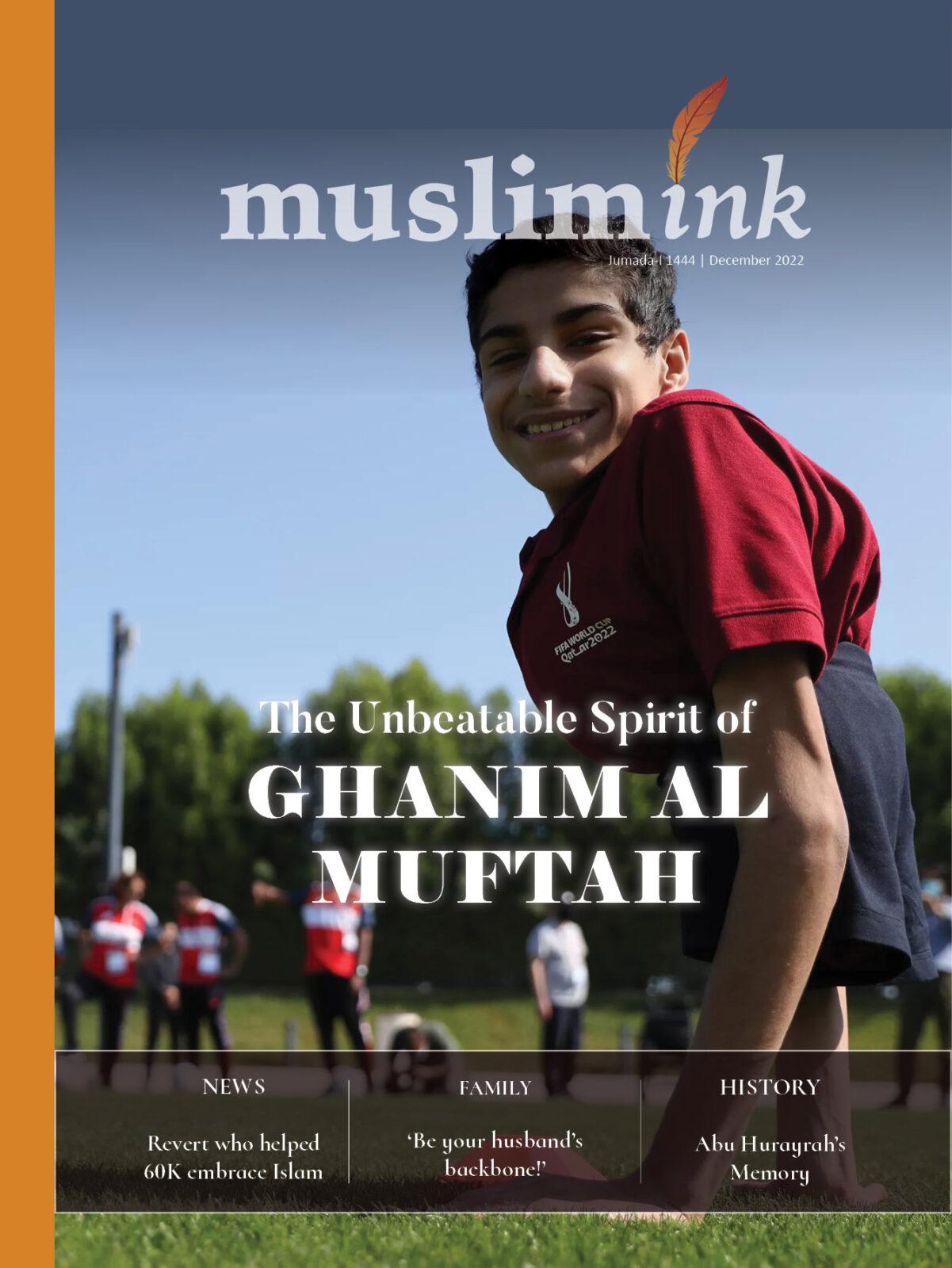





 Dr. Bilal Philips
Dr. Bilal Philips